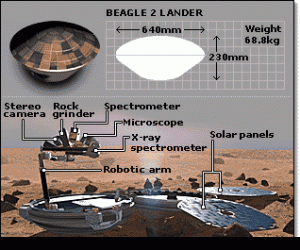50 objects for 50 years: No 12. Beagle 2 – looking for life, saving lives
Monday, July 9th, 2018BBC image of there dustbin-lid-sized Beagle 2
The OU’s Planetary and Space Sciences Research Institute, PSSRI, is the largest planetary sciences group in the UK. A founder member was Colin Pillinger, CBE FRS FRAS FRGS (1943-2014) who joined the OU in 1984. The Planetary and Space Sciences Research Institute was where the Gas Analysis Package was developed. The package was a miniaturized version of the instruments used in the laboratory to analyse meteorites. It was designed to determine whether conditions were ever conducive to life on Mars.
In 2003 Professor Pillinger led a project, in collaboration with the University of Leicester, to build a craft, Beagle 2 which could be transported by the European Space Agency’s Mars Expressmission and then launched towards the surface of Mars. In the television series ‘Life on Mars’(first broadcast 2006–07) the time-travelling central character’s understanding of his situation was significantly improved through a late- night OU-style television programme which offered highly relevant knowledge. This rather tenuous connection of the OU to Mars was eclipsed by Pillinger’s efforts to work with the media. Pillinger ‘captured the imagination of the British public’ as Tim Radford noted. Beagle helped to popularise exploration by involving artists. Blur wrote a song to be used as a call sign and Damien Hurst provided a spot painting to be used to calibrate the craft’s camera. ‘Want more children to study science? Look to Colin Pillinger for inspiration’ as one headline put it. Pillinger himself appeared on a number of popular television programmes and in the press to explain his work.
Beagle 2 got to Mars but then suffered a failure which meant that it could not send data to earth. However, within a few months of the demise of Beagle 2, Pillinger was arguing for a Beagle 3. Pillinger also played a role in the Philae lander which, after his death in 2014, was used to conduct gas chromotograph mass spectrometer experiments on Comet 67P Churyumov/Gerasimenko.
During a period when cases of TB were rising to about two million fatal cases a year, particularly in sub-Saharan Africa, diagnosis relied mainly on the use of smear microscopy of sputum samples, a very labour-intensive process with low sensitivity. This was expensive and slow. Working with the London School of Hygiene and Tropical Medicine and funded by the Wellcome Trust, the OU developed that the OU’s gas chromatograph–mass spectrometer, based on the research carried out for Mars, so that it could accurately detect TB bacteria in a lung. Tuberculosis requires rapid diagnosis to prevent further transmission and allow prompt administration of treatment. The use of gas chromatography- electron impact mass spectrometry provided an alternative solution.
